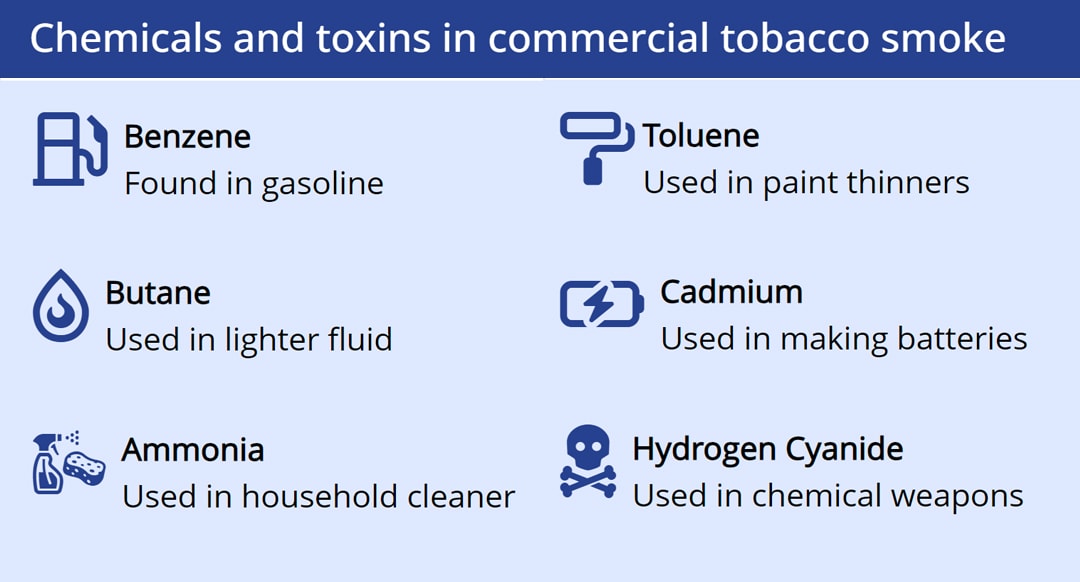At a glance
- Exposure to secondhand smoke from burning tobacco products causes disease and premature death among people who do not smoke.
- There is no safe level of exposure to secondhand smoke. Even brief exposure can cause immediate harm.
- Comprehensive smokefree laws are laws that prohibit smoking in all workplaces and public places, including restaurants and bars.
- Comprehensive smokefree laws and policies fully protect people from secondhand smoke exposure.
Key points
- Secondhand smoke is smoke from burning tobacco products, like cigarettes, cigars, hookahs, or pipes.123
- Secondhand smoke exposure occurs when people breathe in smoke breathed out by people who smoke or from burning tobacco products.
- There is no safe level of exposure to secondhand smoke. Even brief exposure can cause serious health problems and be deadly.
- Completely eliminating smoking is the only way to fully protect people who do not smoke from secondhand smoke exposure.4
Secondhand smoke is harmful
Commercial tobacco smoke contains hundreds of harmful chemicals.A There are more than 7,000 chemicals in commercial tobacco smoke, including hundreds of chemicals that are toxic and about 70 that can cause cancer.156
Here are just a few of the chemicals and toxins in commercial tobacco smoke:

There is no safe level of exposure to secondhand smoke.4 Even brief exposure can cause serious health problems.145 Secondhand smoke can cause coronary heart disease, stroke, and lung cancer in adults who do not smoke.14 Infants and young children are especially impacted by health problems caused by secondhand smoke because their bodies are still growing. Children exposed to secondhand smoke are at an increased risk for:14
- Sudden infant death syndrome (SIDS)
- Acute respiratory infections, such as pneumonia and bronchitis
- Middle ear disease
- More frequent and severe asthma
- Respiratory symptoms
- Slowed lung growth.
Most people are exposed to secondhand smoke in homes and at work
Most people are exposed to secondhand smoke in their homes or their places of work. People may also be exposed to secondhand smoke in public places like bars, restaurants, and casinos.145
People are more likely to be exposed to secondhand smoke if they live in multi-unit housing—like apartment buildings with many homes next to one another in the same place.78 Even when no one in the home smokes, secondhand smoke can drift from other units including through hallways, stairwells, and ventilation systems.8
Protecting people from secondhand smoke exposure
The harm caused by secondhand smoke is preventable. Eliminating smoking is the only way to fully protect people from secondhand smoke exposure.
Comprehensive smokefree laws and policies that prohibit smoking in all areas of indoor spaces are the only way to fully protect people who do not smoke from secondhand smoke exposure.4 Comprehensive smokefree laws and policies can also help people quit smoking and can help keep young people from starting to smoke.4910 These laws and policies must be applied equitably to ensure that all people have a fair and just opportunity to breathe smokefree air and be as healthy as possible.
Most comprehensive smokefree laws and policies also prohibit the use of e-cigarettes. The e-cigarette aerosol that people who use e-cigarettes breathe from the device and exhale can contain harmful and potentially harmful substances.11
Including e-cigarettes in smokefree or tobacco-free policies can protect people who do not use e-cigarettes from exposure to e-cigarette emissions. It can also help change social norms about tobacco use.
More information about e-cigarettes can be found on the Electronic cigarettes webpage.
- Commercial tobacco is defined as the harmful products that are made and sold by tobacco companies. It does not include the sacred or traditional tobacco used by some American Indian communities.
- U.S. Dept of Health and Human Services. The Health Consequences of Smoking—50 Years of Progress: A Report of the Surgeon General. Centers for Disease Control and Prevention, U.S. Dept of Health and Human Services; 2014.
- Institute of Medicine Committee on Secondhand Smoke Exposure and Acute Coronary Events. Secondhand Smoke Exposure and Cardiovascular Effects: Making Sense of the Evidence. National Academies Press; 2010.
- National Toxicology Program. Report on Carcinogens, Fourteenth Edition. U.S. Dept of Health and Human Services; 2016.
- U.S. Dept of Health and Human Services. The Health Consequences of Involuntary Exposure to Tobacco Smoke: A Report of the Surgeon General. U.S. Dept of Health and Human Services; 2006.
- U.S. Dept of Health and Human Services. A Report of the Surgeon General: How Tobacco Smoke Causes Disease: What It Means to You. U.S. Dept of Health and Human Services; 2010.
- National Cancer Institute. Harms of Cigarette Smoking and Health Benefits of Quitting. Accessed July 13, 2022. https://www.cancer.gov/about-cancer/causes-prevention/risk/tobacco/cessation-fact-sheet.
- Walton K, Gentzke AS, Murphy-Hoefer R, Kenemer B, Neff LJ. Exposure to Secondhand Smoke in Homes and Vehicles Among U.S. Youths, United States, 2011-2019. Prev Chronic Dis. 2020;17:200107.
- Wilson KM, Klein JD, Blumkin AK, Gottlieb M, Winickoff JP. Tobacco-smoke exposure in children who live in multiunit housing. Pediatrics. 2011;127(1):85-92.
- Hopkins DP, Razi S, Leeks KD, et al. Smoke-free policies to reduce tobacco use: A systematic review. Am J Prev Med. 2010;38(2 Suppl):S275–S289.
- Siegel M, Albers AB, Cheng DM, Biener L, Rigotti NA. Local restaurant smoking regulations and the adolescent smoking initiation process: Results of a multilevel contextual analysis among Massachusetts youth. Arch Pediatr Adolesc Med. 2008;162(5):477–483.
- U.S. Dept of Health and Human Services. E-cigarette Use Among Youth and Young Adults: A Report of the Surgeon General. U.S. Dept of Health and Human Services; 2016.
